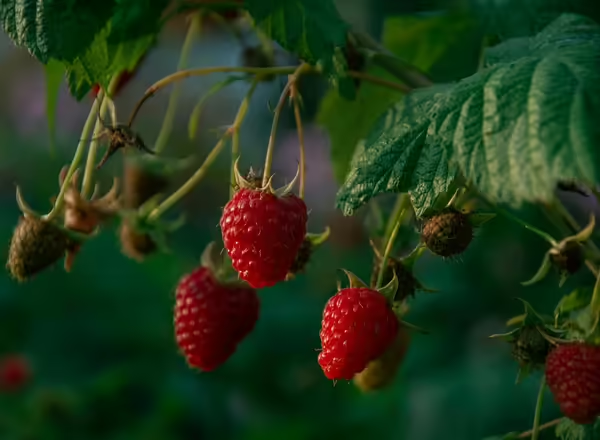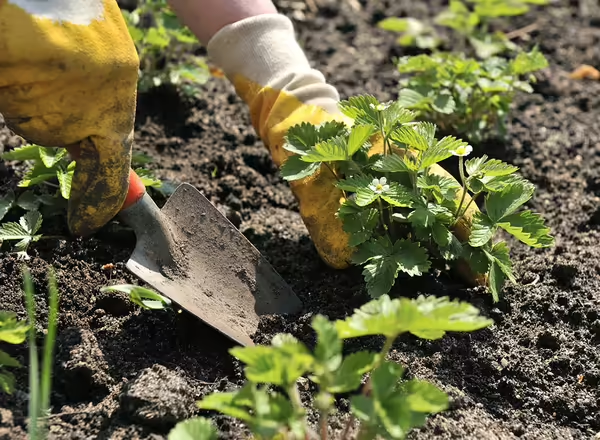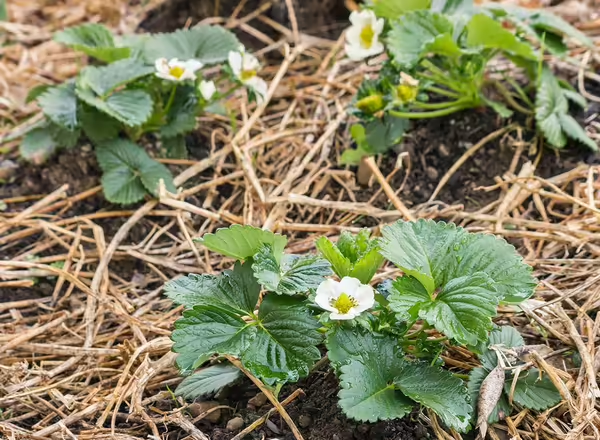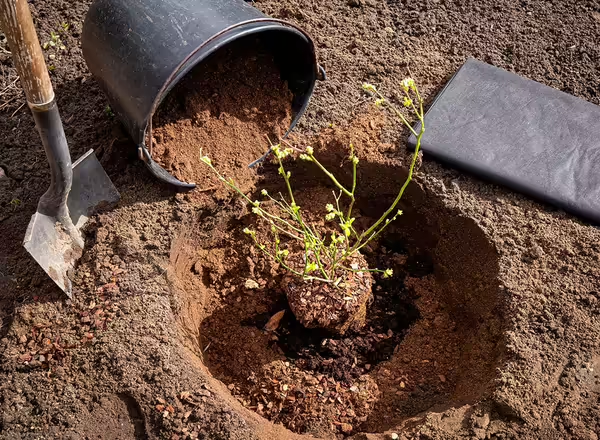
Growing Backyard Fruits
A well-planned garden supplies fresh fruit from early spring to the first killing frost in the fall. The fruits produced are enjoyed for their pleasant taste as well as for their dietary value as sources of vitamins, minerals, acids, and anti-cancer agents. Fruits of the best cultivars, harvested at the peak of their season, cannot be matched in the market regardless of price. Surplus production can be canned, frozen, or dried for use year-round.
Aside from the benefits of superior quality, the care and cultivation of small fruits at home can pro- vide much pleasure and satisfaction. Careful selection of early- and late-season cultivars of different small fruits will supply fresh fruit over the longest possible season. Success, of course, also depends on careful attention to cultural details. This unit describes cultural techniques and cultivars for reliable production in Illinois home gardens.

The number of plants the home gardener can grow is determined by the space and time available as well as the needs of the family. Home fruit plantings should be limited in size, especially if the primary objective is only to supply fresh fruit for home use. Large plantings may be justified for local sales or a 4-H project. The best advice is to plant no more than you can properly care for. Neglected plants produce low yields of poor-quality fruit, harbor destructive insects and diseases, and can be unsightly.
Plant spacing, approximate yields, and a suggested number of plants for a family of five are given in Table M-1.
| Fruit* | Planting distance** between rows | Distance** between plants in row | Time from planting to fruiting | Life of plants |
Height of mature plants
|
Estimated annual yield per plant*** | Suggested number of plants for family of 5 |
| Strawberries (matted row) | 4 ft. | 2 ft. | 1 year | 3 to 4 years | 1 ft. | 1 1/2 to 1 qt/row | 50 to 100 |
| Strawberries Everbearing (hills) | 1 to 1 1/2 ft. | 1 to 1 1/2 ft. | 1/2 year | 2 to 3 years | 1 ft. | 1/2 quart |
100 |
| Raspberries: Red | 8 to 10 ft. | 2 to 3 ft. | 1 year | 8 to 10 years | 4 to 6 ft. | 1 1/2 quarts | 20 to 25 |
| Raspberries: Everbearing red | 8 to 10 ft. | 3 ft. | 1 year | 8 to 10 years | 4 to 6 ft. | 1 qt. spring | 15 to 20 |
| Raspberries: Black | 8 to 10 ft. | 3 ft. | 1 year | 8 to 10 years | 4 to 5 ft. | 1 qt. | 20 to 25 |
| Raspberries: Purple | 8 to 10 ft. | 3 ft. | 1 year | 8 to 10 years | 4 to 5 ft. | 1 to 1 1/2 quarts | 20 to 25 |
| Currants | 6 to 8 ft. | 4 ft. | 2 years | 12 to 15 years | 3 to 4 ft. | 3 to 4 quarts | 2 to 4 |
| Gooseberries | 6 to 8 ft. | 4 ft. | 2 years | 12 to 15 years | 3 to 4 ft. | 4 to 5 quarts | 2 to 4 |
| Blackberries: Erect | 8 to 10 ft. | 2 to 3 ft. | 1 year | 10 to 12 years | 3 to 6 ft. | 1 quart | 15 to 20 |
| Blackberries: Thornless, trailing | 8 to 10 ft. | 6 to 10 ft. | 1 year | 8 to 10 years | 6 to 8 ft. | 4 to 10 quarts | 8 to 10 |
| Blueberries | 8 to 10 ft. | 6 to 8 ft. | 3 years | 20+ | 5 to 8 ft. | 6 to 10 quarts |
6 to 8 |
| Grapes | 8 to 10 ft. | 8 to 10 ft. | 2 years | 20+ | 5 to 6 ft. trellised | 1 1/2 bushel | 5 to 10 |
- * Listed in approximate order of ripening from early spring to fall.
- ** Minimum suggested spacings. If a tractor is available, space the roes to fit the equipment.
- ***At full bearing age, with good care.
Although there is no sharp demarcation between northern, central, and southern Illinois, some cultivars definitely perform better at a specific latitude. For the purposes of this manual, we have defined the regions as
- N = region north of Interstate 80
- C = central region between Interstate 80 at the north and Interstate 70 at the south
- S = region south of Interstate 70
The yields shown are dependent upon proper cultivar selection and good management. The size and layout of the garden may vary according to the selection of fruits desired and the space and location available. To prevent shading when arranging small fruits in the garden, place the taller-growing fruits such as trellised grapes north of lower-growing fruits such as strawberries.


It is a good idea to locate the small fruit garden near the house. If large trees are nearby, locate the garden to the south of them, if possible. There is an advantage in planting adjacent to the vegetable garden for convenience of doing cultural chores. However, sometimes the most convenient location does not have the most desirable exposure, soil, or water drainage.
The site should have reasonably fertile soil and be well drained. Avoid areas that collect water after a rain. A moderately elevated or sloping site will reduce losses from late spring frosts and provide better water drainage. Exposure to full sunlight is preferred, although most small fruits will grow in partial shade.
Black raspberries and gooseberries can stand more shade than other small fruits. Wherever possible, take advantage of windbreaks such as buildings and hedgerows to protect the planting from severe prevailing northwest winter winds.
Strawberries and brambles should not be planted on a site where tomatoes, potatoes, peppers, eggplant, melons, okra, peas, beets, or roses have been grown in the past three to five years. Verticillium wilt is a dis- ease common to all these crops, and if they are not rotated with non-susceptible crops, severe losses can result. There are Verticillium-resistant strawberry and raspberry cultivars available; some of these cultivars are listed in the appropriate section later in this unit.



Most small fruit plants will occupy the same location at least three years and as long as thirty or more years. Therefore, it is desirable to build up the soil fertility of the proposed planting site before planting.
Planning one or two years ahead can also help to reduce weed problems.
All small fruit plants benefit from the addition of organic matter to the soil. If composted manure that is free of weed seed is available, incorporate four bushels (or 100 pounds) per 100 square feet in the summer or fall before planting. Similar levels of com- post, decomposed leaves, or lawn clippings can also in- crease the soil’s organic-matter level. Use only lawn clippings that have not been treated with herbicides. It is a good idea to add ten to fifteen pounds of 10-10-10 fertilizer (or equivalent) per 1,000 square feet when leaves are used. Thoroughly work the organic material into the soil. In September, sow a cover crop such as annual rye at three pounds of seeds per 1,000 square feet to protect the soil during winter. Turn the crop under in spring to improve the soil.
To reduce weeds, plant and cultivate row crops for one or two years prior to planting small fruits. Avoid the Verticillium-susceptible crops listed earlier. Also, avoid sites where herbicides with long carry-over periods have been used recently. Regular cultivation and hoeing will be necessary to control weeds. The cultivation helps improve soil conditions by mixing organic matter in the soil and increasing aeration.
If sod must be turned under, it should be done in fall to allow decomposition to begin. Sod often harbors grubs (insect larvae) that feed on roots. Most of the grubs die if the sod is turned under and the ground cultivated at least one year prior to planting. All small fruits except blueberries grow satisfactorily in a soil pH range of 5.5 to 7.5. Blueberries require a pH of 4.8 to 5.2 for best growth. The pH measurement refers to the relative acidity or alkalinity of the soil: 7 is neutral, 6 to 7 is slightly acid, and 7 to 8 is slightly basic (alkaline).
Prior to planting, work the soil as thoroughly as you would in planting a vegetable garden. The soil should be well pulverized and moist, and soil granulation should be no larger than a pea.